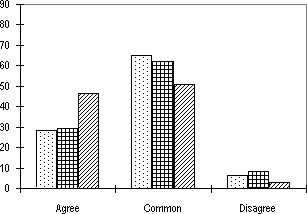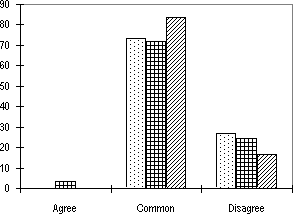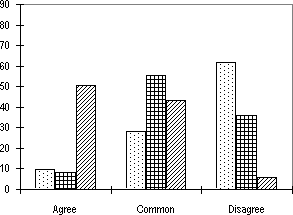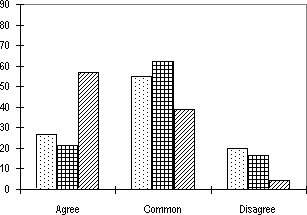
Figure 1. AC electric generator (top) and DC electric generator (bottom).

Virtual Reality Simulations in Physics Education
Jong-Heon
Kim, Kongju National University
Sang-Tae Park, Kongju National University
Heebok Lee, Kongju National
University
Keun-Cheol Yuk, Kongju National University
Heeman Lee,
Seowon University
About
the authors...
Abstract
A virtual reality
physics simulation (VRPS) is an educational tool using a virtual reality interface
that brings together a 3D model of real apparatus and a virtual visualization
of physical situations in an interactive manner. VRPS enhances students' understanding
by providing a degree of reality unattainable in a traditional two-dimensional
interface, creating a sensory-rich interactive learning environment. In this
paper, we present a computer-based virtual reality simulation that helps students
to learn physics concepts such as wave propagation, ray optics, relative velocity,
electric machines, etc. at the level of high school or college physics.
1. Introduction
Virtual reality
(VR) is defined as a highly interactive, computer-based multimedia environment
in which the user becomes the participant in a computer-generated world. A key
feature of VR is real-time interactivity where the computer is able to detect
user inputs and instantaneously modify the virtual world in accordance with
user interactions. VR environments often consist of technological hardware including
computers, head-mounted displays (HMD), eye phones, and motion-sensing data
gloves. Virtual reality technology may offer strong benefits in science education
not only by facilitating constructivist learning activities but also by supporting
different types of learners such as those who are visually oriented.
Distance learning has been popularized in recent years because of the fast development of computer systems and the spreading Internet connectivity. One of the major restrictions for distance learning in science and engineering education is the difficulty of laboratory activities. One way to overcome these difficulties is to use simulation programs running on a Web browser instead of requiring hands-on experiments. However, most simulation programs used to demonstrate physical experiments are displayed in 2D and, thus, lack realism.
A virtual reality simulation program is one solution for realistic hands-on experimentation. Furthermore, it has an additional benefit. Physical phenomena that are neither easy to perceive nor to measure in usual experiments can be presented in a virtual world and can be viewed in many different perspectives in a VR laboratory. In addition, dangerous, high cost, and complicated experiments can be realized in a VR system for distance learners.
In this paper, we will present the recent development of a computer-based virtual reality simulation which permits students to learn physics concepts such as wave propagation, ray optics, relative velocity, and electric machines, etc. at the level of high school or college physics.
2. VR Applications in
Education
Within the higher education
community, multimedia is being used more and more and with increasing success.
Multimedia-based systems provide the student with a very rich source of educational
material in a form that makes learning exciting. VR has extremely wide applications
across a whole range of disciplines, and the enabling technology has reached
a sufficient level of maturity for it to be seriously applied to education,
training, and research in higher education. However, until fairly recently VR
systems have not had the performance to be seriously considered for anything
other than research tools. Furthermore, the costs associated with a VR system
have been prohibitive for educational establishments. (This is still true for
fully immersive VR systems). The good news is that recent technological developments
in computer hardware and software now make it feasible to look at VR as an important
teaching aid (e.g., Byrne, C. 1993).
It is certain that the flexibility provided by a VR system will be a major attraction to the educational community. Even though the cost of entry is quite high compared to conventional multimedia systems, this is quickly offset when one considers the different applications it can support. It is not too difficult to imagine a time when school laboratories are replaced or augmented by a number of VR systems where experiments can be performed. The major difference is that the VR-based laboratory will be able to support chemistry, physics and engineering sessions instead of covering a single discipline.
The VR world can also be used to circumvent the physical, safety, and cost constraints that limit schools in the types of environments they can provide for learning-by-doing. For example, it would be very effective to allow students studying nuclear engineering to further their understanding of the nuclear reactor by moving into the reactor with HMD and 3D gloves. This type of activity can be performed in a virtual world. As this example hints, VR learning environments can also support the notion of situated learning where students learn in the actual context where that learning is to be applied.
3. VR Simulation Programs
in Physics Education
We have used the 3D Webmaster
software for authoring VRPS programs. 3D Webmaster is a powerful windows application
for creating interactive 3D Web pages. 3D Webmaster is the browser platform
that lets you display, move around, and interact with virtual worlds. It lets
you adjust viewpoints, display options and device configurations, and add the
final touches to your world. The worlds you create can be displayed on the fully
interactive environments in 2D HTML pages. You can add URLs to objects so that
you can link directly from your virtual world to any other 2D or 3D page on
the WWW. In order to create realistic worlds, you can use the script language
(Supercape Control Language, SCL) to control the behavior of objects in the
world, perform complex actions, and modify your worlds based on the user's actions.
The VRPS sample programs developed in this study are described below.

Figure 1. AC electric
generator (top) and DC electric generator (bottom).
![]() An interactive demo (~45 KB) of the AC generator.
An interactive demo (~45 KB) of the AC generator.
Require Internet Explorer 5 or above, and Viscape plugin.
![]() A screenshot AVI movie (3.3 MB) showing how the VRPS program of the AC electric
generator.
A screenshot AVI movie (3.3 MB) showing how the VRPS program of the AC electric
generator.
![]() An interactive demo (~44 KB) of the DC generator.
An interactive demo (~44 KB) of the DC generator.
Require Internet Explorer 5 or above, and Viscape plugin.
Viscape can be downloaded from Superscape.com.
Figure 1 shows the VRPS programs of AC/DC electric generators where a student can investigate the generators by dragging the control icons in the plug-in program. Also, the student can change the viewpoint to see details of the generators and watch the output voltage in a voltmeter while switching the direction of the magnetic field, changing the intensity of the magnetic field, and adjusting the frequency of revolutions, etc. These kinds of 3D VRPS programs are powerful tools for learning-by-doing experiments in science education for distance learners.

Figure 2. Water waves.
![]() An interactive demo (~210 KB) of spherical wave.
An interactive demo (~210 KB) of spherical wave.
Require Viscape plugin.
![]() An interactive demo (~30 KB) of plane wave.
An interactive demo (~30 KB) of plane wave.
Require Internet Explorer 5 or above, and Viscape plugin.
Viscape can be downloaded from Superscape.com.
The VRPS programs for the propagation of water waves are shown in Figure 2. The spherical wave (top) and a plane wave (bottom) are modeled in the VRPS programs with changeable wavelengths and viewpoints.

Figure 3. Simple harmonic oscillator.
![]() An interactive demo (~30 KB) of simple harmonic oscillator.
An interactive demo (~30 KB) of simple harmonic oscillator.
Require Internet Explorer 5 or above, and Viscape plugin.
Viscape can be downloaded from Superscape.com.

Figure 4. Action and reaction.
![]() An interactive demo (~30 KB) of action and reaction.
An interactive demo (~30 KB) of action and reaction.
Require Internet Explorer 5 or above, and Viscape plugin.
Viscape can be downloaded from Superscape.com.
Figure 3 shows the simple harmonic oscillator (SHO) with a white ball in a circular motion. The motion of a ball is synchronized with the SHO. By changing the viewpoint from the top view, the student can understand the description of the SHO as a projection of a ball in a circular motion. Various oscillation frequencies can be observed by selecting different mass and spring constants.
The virtual experiment for action and reaction is shown in Figure 4. In this experiment, a person is seen walking on a thick board located on a frictionless floor. The student can select the character's walking speed and watch the motion of the man and the board.
We have developed many other VRPS programs such as ray optics, relative velocity, electric machines, etc. on the level of high school or college physics
4. An Assessment of the
Pedagogical Effectiveness
We selected three groups
in a junior high school to assess the pedagogical effectiveness for one of our
VRPS programs. The subject of the assessment was the AC/DC electric generator
programs. The students were supposed to learn about the structure of the AC/DC
generators and the characteristics of their output voltages. Each group consisted
of two classes of around 35. After presenting these, we tested the students'
knowledge improvement and surveyed the students' attitudes about the VRPS programs.
The first group didn't use the VRPS programs at all; instead, they were taught by traditional methods such as OHP and multimedia courseware. In the second group, the VRPS program was used in the class only by a teacher as a supplement to lecture. The third group used the VRPS program in the PC room where the students were actively engaged by themselves without any lecture. They had only the study guide papers and were expected to learn by themselves. We called the first assessment group "the teacher-centered group," the second assessment group "the teacher-centered VR group,+ and the third assessment group "the learner-centered VR group."
Figure 5 shows the academic achievement of each group before they were taught the VRPS program. The teacher-centered group was slightly superior in academic achievement to other groups.

Figure 5. The academic achievement of each group before the assessment
Academic achievement was
measured by a written examination after two hours of course work for each group,
as shown in Figure 6. Since the subject of the courseware is highly dependent
on visualization in 3D space, it is not surprising that a dramatic improvement
of academic achievement was found in the learner-centered VR group. The academic
achievement of the teacher-centered VR group was also better than the teacher-centered
group.

Figure 6. The academic achievement of each group after the course work
The survey results of students' responses about the course work are shown in Figure 7. We asked students the following questions. (a) Do you think the teaching materials were useful in helping you to understand the subject? (b) Do you think the class hours were sufficient? (c) Do you understand the subject? (d) Did you like the teaching methods? The survey results indicate that the students in the learner-centered VR group were more satisfied with their instruction; they felt that they understood the subject better; and they found the teaching methods more engaging. From the assessment we can infer the VRPS are very useful as teaching materials especially in case of highly interactive visualization of abstract concepts such as electromagnetic phenomena.




Figure 7. The survey results of students' responses about the course work: (a) Do you think teaching materials were useful in helping you to understand the subject? (b) Do you think the class hours were sufficient? (c) Do you understand the subject? (d) Do you like teaching methods? The light gray bar graph is for the teacher-centered group (left bar); the mesh bar graph is for the teacher-centered VR group (center bar); and the dark gray bar graph is for the learner-centered VR group (right bar).
5. Conclusion
There is a need to develop new VRPS programs for distance education as well
as for the regular classroom. The VRPS program is useful for realistic hands-on
experimentation, visualization of invisible physical quantities, and replacement
of dangerous, high cost, and complicated experiments. This paper presents VRPS
programs which enhance students' understanding by providing a degree of reality
within rich interactive learning environments. We have developed VRPS programs
for key physics concepts such as wave propagation, ray optics, relative velocity,
and electric machines, etc. at the level of high school or college physics.
We have assessed the pedagogical effectiveness for one of our VRPS programs.
Student academic achievement shows a higher level of learning in the learner-centered
VR group. The survey results also indicate that the students in the learner-centered
VR group were more satisfied, felt that they understood better, and were more
interested in the VRPS than in other teaching materials.
6. Acknowledgement
This work was supported by Korea Research Foundation Grant (KRF-99-005-D00076).
![]() Examples of VRPS programs can be accessed to http://heebok.kongju.ac.kr/VRPS
Examples of VRPS programs can be accessed to http://heebok.kongju.ac.kr/VRPS
7. References
Byrne, C. (1993). Virtual
Reality and Education. University of Washington, Human Interface Technology
Laboratory of the Washington Technology Center, Seattle, WA. Technical Publication
R-93-6.
C. Youngblut. (1998). Educational Use of Virtual Reality Technology. Institute for Defense Analyses. IDA Document D-2128. Log:H98-000105.
Wayne, T. (1997). Student Responses to Their Immersion in a Virtual Environment. University of Washington, Human Interface Technology Laboratory of the Washington Technology Center, Seattle, WA. Technical Publication R-97-11.
Winn, W. (1993). A Conceptual Basis for Educational Applications of Virtual Reality. University of Washington, Human Interface Technology Laboratory of the Washington Technology Center, Seattle, WA. Technical Publication R-93-9.
********** End of Document **********
| IMEJ multimedia team member assigned to this paper | Yue-Ling Wong |